You’ve probably noticed more cameras appearing in public spaces, but you might not realize how dramatically surveillance technology has evolved to protect your privacy. Modern occupancy detection systems can now monitor crowd levels and space usage without ever identifying who you are or storing your personal information. These privacy-first cameras process everything locally, blur faces in real-time, and only capture anonymous headcounts—but there’s much more happening behind the scenes that’ll surprise you.
Understanding Privacy-Safe Camera Technology

While traditional surveillance cameras raise serious privacy concerns, privacy-safe camera occupancy detection revolutionizes how you can monitor spaces without compromising individual anonymity.
Revolutionary camera technology delivers accurate occupancy monitoring while completely protecting individual privacy and anonymity in any space.
This advanced technology uses sophisticated algorithms that count people while actively preventing personal identification. You’ll find these systems blur or pixelate faces in real-time, ensuring no identifiable features are captured or stored.
What makes this technology particularly valuable is its compatibility with existing CCTV infrastructure, allowing cost-effective implementation without major overhauls.
The privacy-safe approach focuses exclusively on occupancy detection numbers rather than tracking individuals, greatly reducing data protection risks. These systems are specifically designed to comply with strict regulations like GDPR, ensuring your monitoring practices respect privacy rights while delivering accurate occupancy data for your operational needs.
How Edge AI Processing Protects Personal Data
Since Edge AI processes data directly on your camera device rather than sending it to remote servers, you’re guaranteed maximum protection for personal information.
Your sensitive visual content never leaves the device, eliminating storage risks and potential data breaches. The system analyzes images locally and only shares occupancy data—simple counts and analytics—while keeping individual identities completely confidential.
You’ll benefit from processing that uses low-resolution images or anonymous data, making personal identification virtually impossible.
This decentralized approach greatly reduces cyber threats since you’re not relying on vulnerable cloud systems.
Edge AI transforms raw visual input into useful occupancy data without compromising privacy, ensuring your personal data remains secure while delivering accurate monitoring results for space management decisions.
Decentralized Vs Cloud-Based Processing Systems
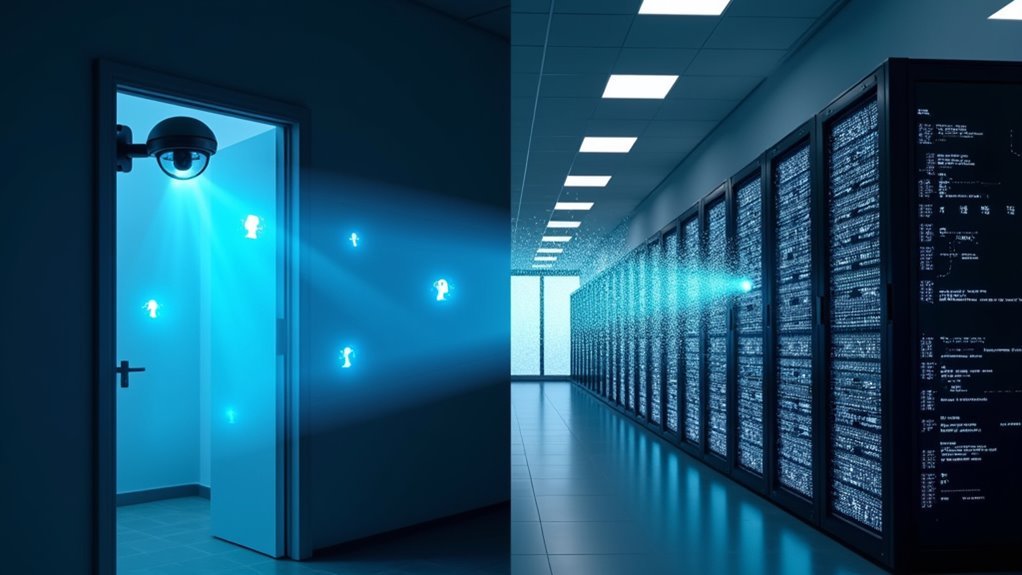
When you’re choosing between decentralized and cloud-based processing for camera occupancy detection, you’ll face a fundamental trade-off between local data control and remote computational power.
Your decentralized system processes video footage directly on the device, keeping sensitive data within your physical premises and eliminating transmission risks.
Cloud-based systems, however, require you to send footage to external servers where it’s vulnerable to breaches and unauthorized access during both transit and storage.
Local Data Processing
Two fundamentally different approaches define how privacy-safe camera occupancy detection systems handle data: local processing and cloud-based processing.
When you choose local data processing, your privacy-safe camera analyzes video and image data directly on-site, eliminating the need to transmit sensitive information to remote servers. This approach notably reduces privacy risks since personal data never leaves your premises.
You’ll experience faster real-time occupancy detection without network latency delays that cloud systems create.
Local processing also cuts your bandwidth requirements, making operations more cost-effective while maintaining compliance with data protection regulations.
Cloud Security Risks
While local processing offers clear privacy advantages, cloud-based camera occupancy detection systems expose your organization to substantial security vulnerabilities that can’t be overlooked.
Cloud security risks include potential data breaches and unauthorized access to sensitive visual information captured by your cameras. High-profile incidents like the Target data breach demonstrate how third-party cloud services can become entry points for hackers.
In contrast, decentralized processing systems enhance security by keeping your data local, markedly reducing hacking risks that accompany cloud connectivity.
When you employ local communication protocols, you minimize exposure to external threats and guarantee visual data doesn’t leave your premises.
You must carefully evaluate the convenience of cloud services against the superior security and privacy that decentralized alternatives provide.
Legal Compliance and GDPR Considerations
You’ll need to navigate strict GDPR compliance requirements when implementing camera-based occupancy detection systems in the EU.
These regulations demand that you minimize personal data collection, conduct mandatory Data Protection Impact Assessments, and guarantee your system captures only aggregate occupancy counts without identifying individuals.
You must also establish clear data retention policies and provide transparent information to individuals about how you’re processing their data.
GDPR Compliance Requirements
When implementing privacy-safe camera occupancy detection systems, you must navigate a complex landscape of GDPR compliance requirements that directly impact how you collect, process, and store data.
These regulations guarantee individual privacy protection while allowing legitimate business operations.
Your GDPR compliance strategy must address three critical areas:
- Data minimization and anonymization – You’ll need to process only essential information and remove identifying characteristics from collected footage.
- Mandatory impact assessments – You must conduct DPIAs to evaluate privacy risks and implement appropriate safeguards before deployment.
- Clear notification and data retention policies – You’re required to inform individuals through visible signage and establish strict timeframes for storing captured data.
Non-compliance carries severe penalties, including fines up to €20 million or 4% of annual turnover.
Data Protection Regulations
Since data protection regulations extend far beyond GDPR’s European scope, organizations worldwide must understand how various privacy laws impact their camera occupancy detection systems.
You’ll need to comply with regional frameworks like California’s CCPA, Canada’s PIPEDA, or Brazil’s LGPD, each carrying unique requirements for data collection and processing.
These data protection regulations typically mandate similar core principles: explicit consent, purpose limitation, and data minimization.
You must implement robust data anonymization techniques to strip personally identifiable information from captured footage. Additionally, you’re obligated to establish clear data retention policies, conduct regular privacy impact assessments, and maintain transparent communication with monitored individuals about your collection practices.
While GDPR sets the highest compliance bar, meeting its standards generally guarantees compatibility with most global privacy frameworks.
Real-Time Occupancy Analytics Without Identity Capture
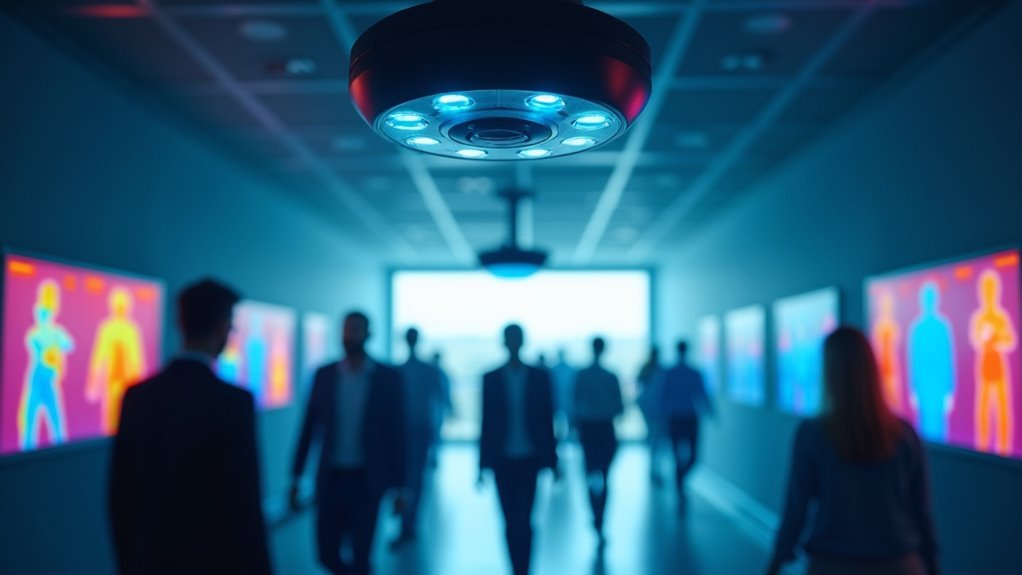
Modern privacy-safe camera systems transform occupancy monitoring by delivering real-time analytics that count people without capturing or storing identifiable features.
You’ll receive instant occupancy status updates while maintaining complete privacy compliance, as these advanced occupancy sensors process visual data without creating permanent records of individuals.
The technology offers three key advantages for real-time monitoring:
- Immediate occupancy insights – You get live headcount data without any lag time or data storage requirements.
- Zero identity exposure – The system anonymizes all visual information before processing, protecting individual privacy.
- Seamless integration – You can access analytics through dashboards and mobile apps for instant decision-making.
This approach guarantees you’re monitoring space utilization effectively while respecting privacy regulations and avoiding the risks associated with traditional surveillance methods.
Energy Management Applications in Smart Buildings
You can transform your smart building’s energy efficiency by implementing privacy-safe occupancy detection to drive three critical management applications.
Your automated HVAC systems will adjust heating and cooling based on real-time occupancy data, while lighting control systems automatically dim or brighten spaces according to actual usage patterns.
These systems work together to generate extensive energy consumption analytics that’ll help you identify waste patterns and optimize your building’s overall energy performance.
Automated HVAC Optimization
When buildings integrate privacy-safe camera occupancy detection with HVAC systems, they reveal energy savings of up to 30% while maintaining ideal comfort levels.
Your smart buildings can dynamically adjust heating, ventilation, and air conditioning based on real-time occupancy data, ensuring you’re not wasting energy on empty spaces.
Advanced detection methods like mmWave radar and PIR sensors deliver accurate occupancy counts without compromising privacy since they don’t capture identifiable images or audio.
Here’s how automated HVAC optimization enhances your energy efficiency:
- Real-time adjustments – Systems automatically reduce heating/cooling in unoccupied areas
- Predictive analytics – Historical occupancy data informs future energy allocation decisions
- Compliance support – Meets sustainability regulations and green building certification requirements
This intelligent approach transforms traditional HVAC operations into responsive, efficient systems.
Lighting Control Systems
Building on HVAC optimization success, privacy-safe camera occupancy detection delivers equally impressive results for lighting control systems.
You’ll achieve energy savings of up to 30% by automatically adjusting lighting levels based on real-time occupancy data. The technology reduces unnecessary lighting in unoccupied areas while ensuring adequate illumination wherever people are present.
Your smart building’s lighting control systems integrate seamlessly with occupancy detection, optimizing energy usage during peak hours and reducing utility costs.
Edge AI technology processes video data locally, minimizing latency for instant lighting adjustments when someone enters or exits a space.
You’ll notice improved occupant comfort and safety alongside enhanced operational efficiency.
This privacy-safe camera occupancy detection approach analyzes video feeds without storing personally identifiable information, maintaining compliance with data protection regulations.
Energy Consumption Analytics
Transform your building’s energy management strategy with thorough consumption analytics that harness occupancy detection data to deliver unprecedented visibility into usage patterns.
When you detect occupancy accurately, your smart building systems can make real-time adjustments that cut energy costs by up to 30%.
Your energy consumption analytics enable three powerful optimization strategies:
- Dynamic Resource Management – Automatically adjust HVAC and lighting based on real-time occupancy data during peak demand periods.
- Predictive Pattern Analysis – Identify underutilized spaces and forecast future consumption trends for better resource allocation.
- Automated Energy-Saving Triggers – Implement automatic dimming and temperature controls in unoccupied areas.
This data-driven approach doesn’t just reduce operational costs—it greatly decreases your building’s carbon footprint while supporting sustainable practices through intelligent energy management.
Security Benefits of Privacy-First Detection Systems
While traditional camera systems create potential vulnerabilities through visual data collection, privacy-first detection systems fundamentally eliminate these security risks by design.
You’ll benefit from occupancy sensing technology that operates without cameras or microphones, removing any possibility of visual or audio data capture that could compromise occupant privacy.
These systems offer significant security benefits by avoiding cloud connectivity, which dramatically reduces your exposure to hacking attempts and data breaches.
You’re protected from unauthorized access since there’s no personal data to steal. Advanced mmWave radar and PIR sensors maintain high detection accuracy while keeping sensitive areas secure.
Privacy-first detection systems guarantee your monitoring needs are met without creating the vulnerabilities that traditional camera-based solutions introduce into your environment.
Implementation Challenges and Technical Requirements
Although privacy-safe camera occupancy detection offers compelling security advantages, you’ll face several implementation hurdles that require careful technical requirements planning.
Your biggest challenge involves balancing sophisticated AI processing with strict data protection compliance. You’ll need high-resolution cameras paired with advanced algorithms that can accurately count people without storing identifiable information.
Sophisticated AI processing must harmonize with strict data protection requirements while maintaining accurate people counting without storing personal identifiers.
Key implementation considerations include:
- Infrastructure Integration – You must seamlessly connect new privacy-safe systems with existing CCTV networks to avoid costly hardware replacements.
- Regulatory Compliance – You’re required to meet GDPR and other data protection standards while maintaining system functionality.
- Edge Computing Setup – You’ll need real-time processing capabilities that minimize network data transmission and enhance privacy protection.
Success depends on choosing solutions that prioritize anonymity while delivering reliable occupancy metrics.
Comparing Privacy-Safe Cameras to Traditional Surveillance
Privacy-safe cameras fundamentally differ from traditional surveillance systems in how they handle personal data and protect individual anonymity. While traditional systems capture high-resolution footage requiring extensive review, privacy-safe cameras use advanced algorithms for occupancy detection without storing identifiable images. You’ll find these systems integrate seamlessly with existing infrastructure while maintaining strict data protection compliance.
| Feature | Privacy-Safe Cameras | Traditional Surveillance |
|---|---|---|
| Data Storage | No identifiable images stored | High-resolution footage retained |
| Privacy Protection | Anonymized, low-resolution data | Potentially invasive monitoring |
| Compliance | Built-in data protection features | Requires additional privacy measures |
| Employee Impact | Improved morale and trust | May create surveillance anxiety |
Research shows organizations using privacy-safe occupancy detection experience enhanced productivity and reduced data breach vulnerabilities.
Best Practices for DIY Smart Home Integration
When building a DIY smart home with privacy-safe occupancy detection, you’ll want to focus on sensors that eliminate visual and audio data collection entirely.
Privacy-focused occupancy detection eliminates visual and audio data collection while maintaining effective smart home automation.
PIR sensors and mmWave radar technology are your best options since they detect the presence of people without capturing identifiable information.
Here are three essential practices for successful integration:
- Choose regulation-compliant sensors that don’t store personally identifiable information or require risky cloud connectivity.
- Prioritize wireless devices for easier scalability and installation without complex wiring.
- Select platform-compatible systems that work seamlessly with existing smart homes frameworks like Home Assistant.
These sensors provide real-time occupancy data while maintaining energy efficiency, potentially reducing your lighting and HVAC costs by up to 30% through automated adjustments based on detected occupancy.
Frequently Asked Questions
What Do Occupancy Sensors Detect?
You’ll find that occupancy sensors detect your presence in spaces using PIR, ultrasonic, or wireless technologies. They measure temperature, humidity, and light while tracking movement patterns without capturing visual or audio data.
Do Occupancy Sensors Have Cameras?
You’ll find most occupancy sensors don’t use cameras. They rely on PIR sensors or mmWave radar instead. This design protects your privacy while detecting movement and presence without capturing visual data.
What Is Privacy Masking in CCTV Cameras?
Privacy masking digitally blurs or obscures specific areas in your CCTV camera’s view to protect people’s privacy. You can block sensitive zones like restrooms while still monitoring other areas for security purposes.


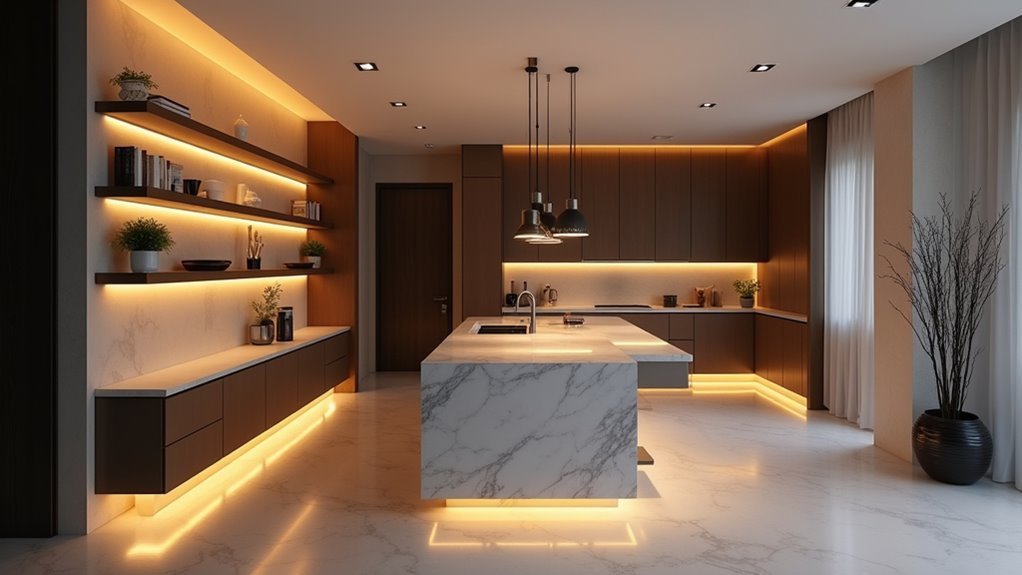
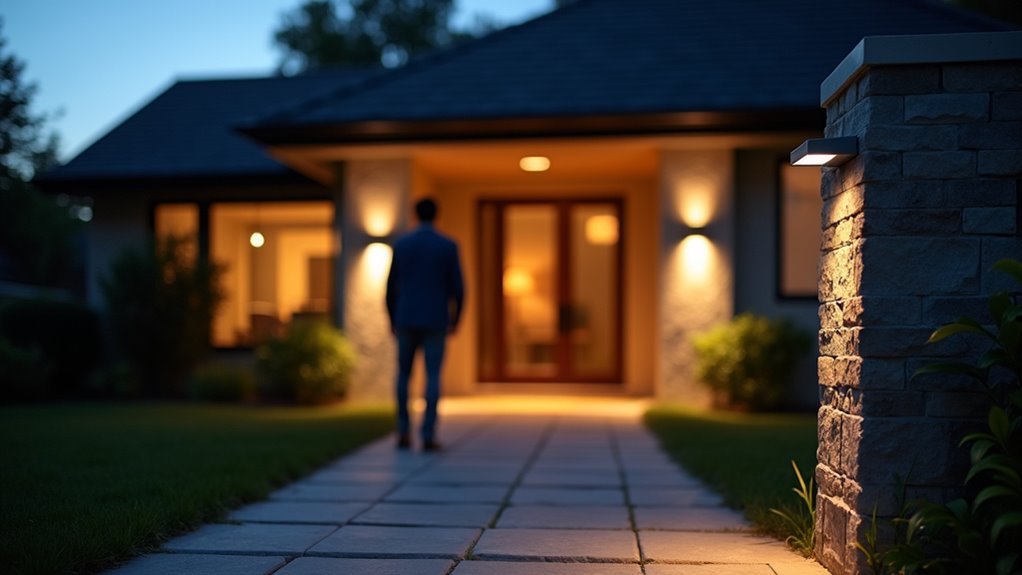
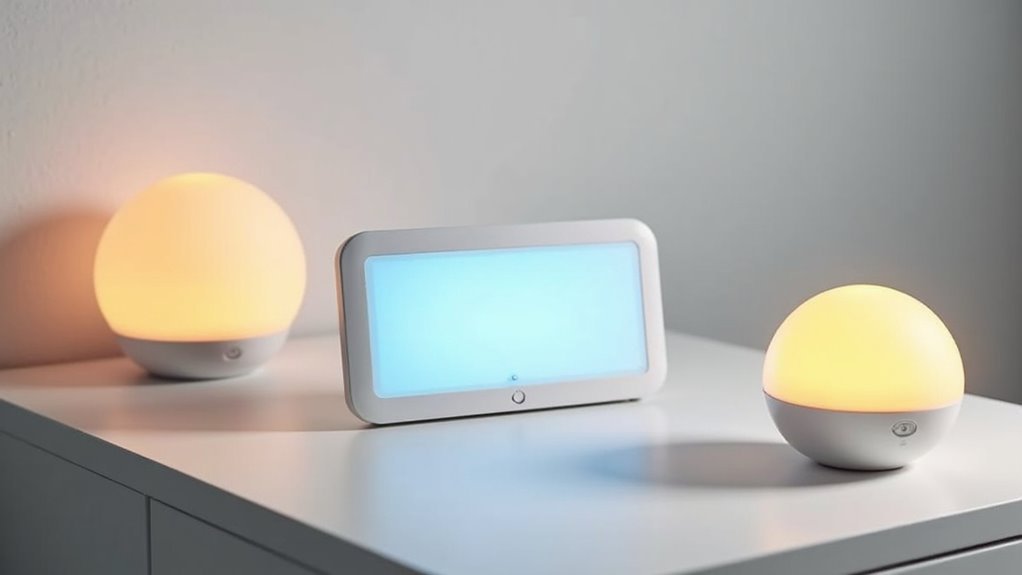
Leave a Reply